Old Walsham Sayings and Tales
One of the old sayings in Walsham about the weather was…
‘If the wind stays up Ella Green (Allwood Green) for three days, it’s there for three weeks.’
This is still true today. Allwood Green lies approximately to the North East of Walsham along the Walsham to Finningham Road by Rob Hall corner, and the wind is known to be persistent when it gets in that direction.
Another weather saying is…
‘do not plant your runner beans until Bardwell Fair is here.’
The reason for this is because Bardwell Fair, which was an old traditional fair, normally came at the first week in May. By that time, when the beans had sprouted, most chances of a frost had gone. There were no calendars then for them to consult, so this was a good guide at planting time.
At harvest time the first corn to be cut was oats at the beginning of August. The variety of oats grown many years ago took a long while to be ready to stack after being cut and stood in the stook. It was always said that…
‘the bells of three Sundays must ring over them’
…and by then the oats were dry enough to cart from field and be stacked.
They also had a sense of humour. Some examples are, if they met someone they may say, “where have yew din boi” the reply would sometimes be “oi nav bin to Langham Docks to watch the boats come in ”.
One night an elderly gentleman was walking through Walsham churchyard when someone jumped out from behind a gravestone with a sheet over his head and making appropriate ghostly noises. The elderly gentleman said “ who are yewe? ” to which the apparition replied “I’m a ghost my boi.” At that the old man whacked him with his walking stick and said “Now dew yew get back from where yew came from then.” Needless to say, that trick was not tried again.
Many years ago, after they had baked the bread, local bakers would for a few pence bake items for the villagers while there was still heat in the oven. One day Miss Bessie Locke from Rookery Farm, who was know to be a thrifty lady, walked to the bakery with a rice pudding to be put in the oven covered with the apron which most women then wore. As she entered the bakery she stumbled, and the rice pudding finished up in her apron. ‘Oh! I am not going to waste that’ she said, and she promptly scraped it from her apron back into the dish, then handed it to the baker to bake.
Often when there was heavy rain, and the farm workers had to work out in it, a favourite choice of wearing apparel was a sack around their shoulders. This was known as their ‘Saxmundham Jacket’. The best one to use was an old corn sack which was made of a very thick hessian. It had to be an old well patched one past further use because the farmer usually hired these, and woe betide any worker using a good one.
Incidentally these corn sacks when filled with corn were very heavy. They held four bushels of corn called a coomb, the weight of which varied according to what the corn was. The lightest was Oats which weighed 12st, Barley weighed 14st. Wheat was 16st, Field Beans weighed 18st, Clover seed 20st. The Clover was red Clover and the crop was used when dried for horse fodder, called stover, pronounced “stuvver” in Suffolk. The workers were expected to carry these sacks sometimes up steps to a granary, and they did. Today some men cannot move a wheelie bin if the lid is not closed because of the health and safety risk to them.
The eqivalent of today‘s weight of the sacks of corn is approximately as follows 12st. or 75.6kl, 14st. or 88.6kl, 16st. or 100.8kl, 18st. or 113.4kl, 20st. or 126.6kl.
As they had to work very hard these men needed to eat well. It always surprised me as a lad to see how much they would eat.
The often-used description today of a “ploughman‘s lunch” is derisory. A real ploughman‘s lunch consisted of half a loaf of bread with perhaps a lump of margarine in the middle. Hunks of bread were carved off with a penknife, together with a piece of cold meat or cheese and a raw onion, washed down with a bottle of cold tea. The knife was wiped on their trousers and put away ready for another use, much different from today‘s ploughman‘s lunch.
I remenber as a boy going one day to help on a farm. My mother packed me some corned beef and tomato sandwiches for my lunch. When the farmer saw what I had to eat he said, “a man can‘t work on that. You must have some more to eat”, so I finished up, in addition to my sandwiches, being given a boiled goose egg with bread and butter, an egg custard with golden syrup and a large piece of fruit cake, plus a cup of tea. Like most boys I somehow managed to eat it all. Almost a ploughman‘s lunch.
John Champion
‘Charlie’s Outings’
‘Charlie’s Outings’ were memorable events in Walsham during the late 1950s and into the 1970’s. These were started by Charlie Studd.
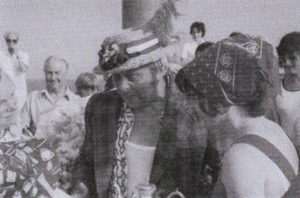
In World War 2 Charlie was taken prisoner by the Japanese. After the war Charlie married Marjory Debenham and settled in Walsham. He decided to do something for the children in Walsham and thought that he would try to take them to the seaside for the day.
To raise money he and his helpers had an annual Jumble Sale in the Memorial Hall, an event that was eagerly anticipated by people in the village.
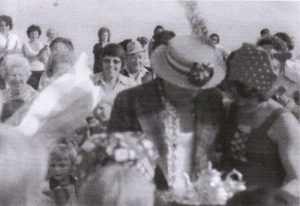
On the day of the sale there was always a large crowd of people waiting for the doors to open. When they did, it was bedlam. Eye-witnesses said there was pushing and pulling and arguments over who had an item first. The hall was packed with potential buyers. Nevertheless most of the items donated were sold, and the tombola stall often took £200.
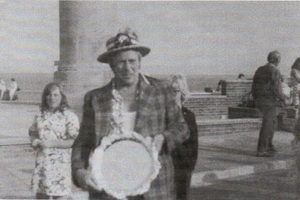
With the money raised it was decided to take the children to the seaside at Lowestoft. Adults were welcome but they paid their own fare. The cost of the coach-hire was paid and any money left over was given to the children to spend on their day out. When the day arrived, there were usually 7 to 8 coaches waiting in The Street to take the children and adults who had assembled in the Memorial Hall car park. After they had all departed, Walsham was like a ghost village.
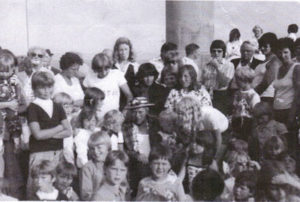
On the way to Lowestoft a stop was made in a lay-by at Homersfield and the children were given drinks, crisps, and sweets before continuing their journey. Arriving at Lowestoft they all made for the beach and congregated in one large group to start with. Some onlookers must have wondered what was happening to see hundreds of people gathered altogether on the beach – Walsham had arrived in force. At the end of the day the children, who were tired but happy, returned to the coaches for the journey home.
When Charlie decided that he would stand down from organizing the Jumble and Outing, it was taken on by Trevor Rolfe who continued the event for another 10 years. Then Ralph Hubbard took on the task for a number of years.
John Champion
Walsham’s Early Bus Service
The first regular daily bus service from Walsham to Bury St. Edmunds was started in February 1924. The make of bus was Tilling Stevens and it was operated by the Eastern Counties Roadcar Co. In 1931 the company was renamed Eastern Counties Omnibus Co.
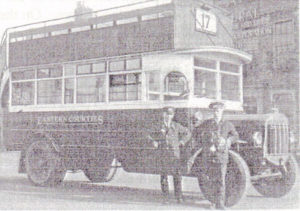
The bus was first manned by two local men – Fred Ellis was the driver and Neil Debenham was the conductor. This duo worked together for several years. In later years the service was extended to run to Stowmarket. Also on a Friday there was a service to Ipswich. On a Sunday afternoon there was a service to Stowmarket and to Bury St Edmunds. Before this there was an occasional bus that went to Bury on Market Days only, run by a private individual.
Acknowledgements
- Ipswich Transport Museum
- Peggy Dryden (for the photograph)
John Champion
John Champion would be interested to see old photographs of Walsham – 01359 259583
60 years of Obituaries and Epitaphs
Our new book of obituaries and epitaphs is now on sale at the price of £3, postage £1. It covers the period from 1890, when the “new” cemetery was opened, until 1950. It is a compilation of obituaries printed in the Bury Free Press during this period. We have also recorded the gravestone epitaphs before erosion makes them more difficult to read. Available from 01359 258535.

